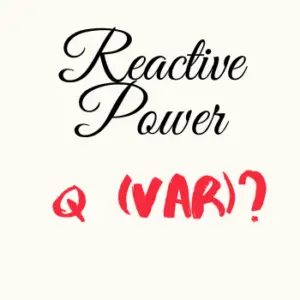Apparent power and reactive power are both important concepts in electrical engineering, particularly in the context of AC circuits.
In this article, we will explore the relationship between these two types of power and how they are related to each other.
Table of Contents
What is Apparent Power?
Apparent power is the total power consumed by an AC circuit, taking into account both the real power and the reactive power.
Real power is the power that is actually used to do work, such as turning a motor or lighting a bulb.
Reactive power, on the other hand, is the power that is used to establish and maintain an electromagnetic field in an inductive or capacitive load, without doing any useful work.
Apparent power is typically measured in volt-amperes (VA), which is the product of the RMS voltage and current in the circuit. The formula for calculating apparent power is:
S = V x I
where S is the apparent power in VA, V is the RMS voltage in volts, and I is the RMS current in amperes.
What is Reactive Power?
Reactive power is the power that is used by inductive or capacitive loads to establish and maintain an electromagnetic field.
In an AC circuit, the current and voltage are constantly changing, and the inductive and capacitive loads cause the current and voltage to become out of phase with each other.
This phase difference results in the reactive power, which flows back and forth between the load and the power source.
Reactive power is measured in volt-amperes reactive (VAR), which is the product of the RMS voltage, the RMS current, and the sine of the phase angle between the voltage and current. The formula for calculating reactive power is:
Q = V x I x sin(θ)
where Q is the reactive power in VAR, V is the RMS voltage in volts, I is the RMS current in amperes, and θ is the phase angle between the voltage and current.
For more information about reactive power read my article here.
The Relationship Between Apparent Power and Reactive Power
Apparent power and reactive power are related to each other through the power factor (PF) of the circuit. The power factor is the ratio of the real power to the apparent power, and it indicates how efficiently the circuit is using the power.
A circuit with a high power factor (close to 1) is using the power efficiently, while a circuit with a low power factor (close to 0) is not using the power efficiently. The power factor can be calculated using the following formula:
PF = P / S
where P is the real power in watts and S is the apparent power in VA.
The reactive power can be calculated using the following formula:
Q = √(S^2 – P^2)
where Q is the reactive power in VAR, S is the apparent power in VA, and P is the real power in watts.
Therefore, we can see that the reactive power is related to the apparent power and the power factor.
A circuit with a low power factor will have a higher reactive power, while a circuit with a high power factor will have a lower reactive power.
Example:
Let’s take an example to understand the relationship between apparent power and reactive power.
Suppose we have a motor that is rated at 10 horsepower and operates on 480 volts AC. The motor has a power factor of 0.8 and an efficiency of 85%. What is the apparent power and the reactive power of the motor?
Solution:
Step 1: Calculate the real power of the motor.
We know that the motor is rated at 10 horsepower, which is equivalent to 7,460 watts.
The efficiency of the motor is 85%, so the actual power consumed by the motor will be:
P = 7,460 / 0.85 = 8,776 watts
Step 2: Calculate the apparent power of the motor. For more information about conversion between apparent power, real and, reactive power read my article here
The formula for calculating apparent power is:
S = V x I
We know that the motor operates on 480 volts AC, so we can calculate the RMS current using the real power and power factor:
P = V x I x PF
I = P / (V x PF) = 8,776 / (480 x 0.8) = 22.89 amps RMS
Therefore, the apparent power of the motor is:
S = V x I = 480 x 22.89 = 10,998 VA
Step 3: Calculate the reactive power of the motor.
We can use the formula for calculating reactive power:
Q = √(S^2 – P^2)
Q = √(10,998^2 – 8,776^2) = 6,231 VAR
Therefore, the reactive power of the motor is 6,231 VAR.
Conclusion:
In conclusion, apparent power and reactive power are both important concepts in electrical engineering, particularly in the context of AC circuits.
Apparent power is the total power consumed by an AC circuit, taking into account both the real power and the reactive power, while reactive power is the power that is used by inductive or capacitive loads to establish and maintain an electromagnetic field.
The reactive power is related to the apparent power and the power factor, and a circuit with a low power factor will have a higher reactive power, while a circuit with a high power factor will have a lower reactive power.
Read my article about The importance apparent power.

